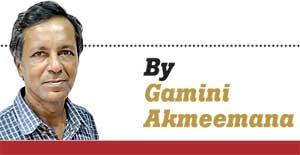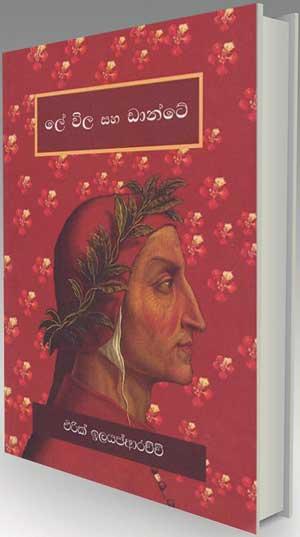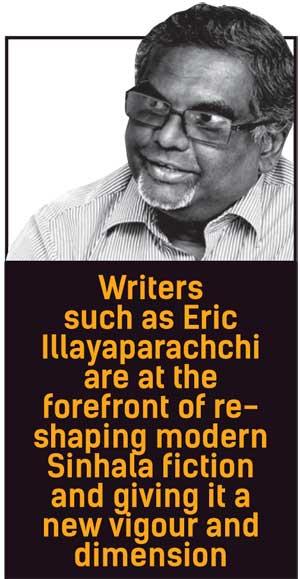Reply To:
Name - Reply Comment
Among contemporary Sinhala fiction writers, there are those who have deliberately struck away from conventional story telling formats, using techniques of fantasy and displaying Post- Modernist and other influences. Fantasy in this case doesn’t mean the Lord of Rings kind. One can discern instead Latin American Magic Realism and even Gothic horror story elements in modern Sinhala fiction.
Modernist and other influences. Fantasy in this case doesn’t mean the Lord of Rings kind. One can discern instead Latin American Magic Realism and even Gothic horror story elements in modern Sinhala fiction.
Eric Illayaparachchi is one of our most prolific and experienced writers, and his literary output ranges from novels and short stories to poetry, travel, literary criticism, essays and even opera librettos. ‘Le Wila Saha Dante’ is a short story collection by him which came out in 2017. Among the most literary of our writers, he starts with two verses from Dante’s Inferno, taken from Canto 1.
Irony and satire are characteristic of Eric’s writing, and the 13 stories in this slim volume are saturated with both qualities. Reading these stories, we are aware of two planes of consciousness. While real places and place names are evoked, the characters are fantasies. They are people who connect the reader with another plane of existence not normally available to him.
While none of these characters vanishes into thin air or flies away, their names, what they do and how they think is enough to startle the reader out of his normal, complacent state of what to expect from a short story collection. There are genres of fiction meant to keep the reader on the edge – horror, for example. While ‘Le Wila Saha Dante’ doesn’t belong to the horror fiction genre, its characters and situations evoke a feeling of horror – about the human conditions, what these characters do and what it might be like to be in their shoes.
 Take, for example, the character of Tesla Jinadasa from the story ‘Classified Ads.’ Just like her name, the character of Tesla too, is a cultural contradiction. She is part of Sri Lanka’s urban pop culture, member of a group of ‘cultural radicals’ to whom the Majestic City shopping complex is a make believe, ‘reality show’ home of sorts with the pain and leaking pipes of domesticity absent. But she chooses to marry a nationalist, a ‘complete Sinhalese’, and goes around Colombo in a Volkswagen Beetle with a lion sticker. This is another contradiction, as the Beetle is a universal symbol of pop culture, while the lion sticker is a glaring icon of Sinhala nationalism.
Take, for example, the character of Tesla Jinadasa from the story ‘Classified Ads.’ Just like her name, the character of Tesla too, is a cultural contradiction. She is part of Sri Lanka’s urban pop culture, member of a group of ‘cultural radicals’ to whom the Majestic City shopping complex is a make believe, ‘reality show’ home of sorts with the pain and leaking pipes of domesticity absent. But she chooses to marry a nationalist, a ‘complete Sinhalese’, and goes around Colombo in a Volkswagen Beetle with a lion sticker. This is another contradiction, as the Beetle is a universal symbol of pop culture, while the lion sticker is a glaring icon of Sinhala nationalism.
Other elements in the story, too, point to similar contradictions. But, beneath this surface mosaic of pop cultural figures and icons, there is a serious, literary undercurrent. One of the boys in this group reads love stories and then tears up the pages. He is their ‘Umberto Eco.’ Tesla Jinadasa comes to a birthday in a striped suit, a stark reminder of Nazi concentration camps, as if she foresees her own oblivion in the gas chambers of this country’s culture wars.
In ‘Ghost Writer,’ the author takes a figure not familiar to the country’s literary culture. Ghost writers are mostly a Western phenomenon, professionals who remain in the shadows while writing books for others. This is relatively unknown in Sri Lanka. But this choice may be the author’s way of telling us that not only cultural contradictions but also exotic cultural phenomena (such as ghost writers) are always capable of implanting themselves in the give and take of social progress and re-shaping in a globalised context.
The situation is made even more comic because the ghost writer Loris Kumaragama is a minor employee at a hospital in distant Puttalama, and it’s a doctor who asks Loris to write a novel for him. Loris has no books, and not even a pen or pencil in his room though he writes ‘everything other than petitions and waskavi.’ The absurdity is stretched further when this debut novel wins a literary prize. But the doctor’s literary career comes to an abrupt end when he learns that his ghost writer is working on another ‘ghost’ novel for a female colleague at the same hospital.
"Beneath this surface mosaic of pop cultural figures and icons, there is a serious, literary undercurrent. One of the boys in this group reads love stories and then tears up the pages"
Such absurd contexts are the author’s way of exposing the underlying absurdity of life. Even in a story such as ‘Ranarala,’ a  seemingly realistic narration set in a village, the characters evoke an abstract landscape with different shades of horror. A young director of wildlife, eager to meet again Theodore Haamu, the old Leftist stalwart of his childhood days, is bitterly disappointed when the meeting does take place. The village is a nest of resentments, thwarted ambition and violent tendencies, leaving the protector of wildlife stranded in a cultural wasteland.
seemingly realistic narration set in a village, the characters evoke an abstract landscape with different shades of horror. A young director of wildlife, eager to meet again Theodore Haamu, the old Leftist stalwart of his childhood days, is bitterly disappointed when the meeting does take place. The village is a nest of resentments, thwarted ambition and violent tendencies, leaving the protector of wildlife stranded in a cultural wasteland.
In “The Lover Who didn’t Love,’ Yuganthi is a school track and field star who happens to be a member of a secretive group of youth known as ‘Che Guevara.’ Having decided that ‘an ascetic life would not suit the simple beauty of her handsome physique,’ she longs for a life at a more exciting plane. That her only route to the terrain of her dreams is political subversion speaks volumes for the tragedy of thousands of young in this country; while today’s generation can escape into Face Book, reality shows, breaking news, drugs, pornography and stimulants, her generation had to resort to political violence as a way out of social austerity and asceticism – or so the author seems to suggest. The final fantasy in the classroom portrays the deep pathos of the sensitive loser who can’t beat the system.
‘The Elections Commissioner’ too, is seemingly straightforward narrative, but a careful reading will show that it is more than that. When former deputy elections commissioner Ganesh dies in London, the task of transporting his body from
Colombo to Jaffna under wartime conditions is entrusted to Pieris, a young deputy commissioner who reveres the deceased legendary figure. Both have the deepest respect for democracy, but there are hints that the present context of their lives is not quite democratic.
The coffin’s journey, by air from London and by road from Colombo, is epic, and full of atmospherics that hint at menace. The way the coffin and the body is handled at the final military checkpoint, as well as the ‘lunch episode’ at the rest house, end any illusion that this is reality we are dealing with. Like in his other stories, the author is hinting at a parallel plane of existence alongside reality, sometimes overwhelming it.
I have never felt that the days of conventional narrative are finished by any means, and that fantasy will replace it in future. But writers such as Eric Illayaparachchi are at the forefront of re-shaping modern Sinhala fiction and giving it a new vigour and dimension.
The book is priced at Rs. 250 and is available at S. Godage and Bros, Colombo 10.